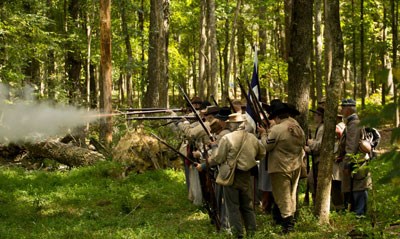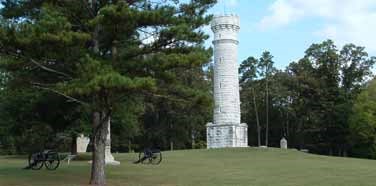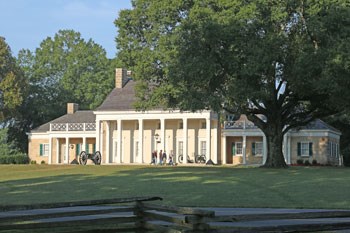
NPS Photo In the late summer of 1863 the Union Army of the Cumberland under the command of General William Rosecrans maneuvered south from middle Tennessee with the objective of capturing the city of Chattanooga, the gateway to the Confederacy. By late September, much of the Union Army crossed Lookout Mountain south of the city and threatened to cut off the Confederate Army of Tennessee, commanded by General Braxton Bragg. Bragg's Confederates withdrew towards LaFayette, Georgia. Both armies then engaged in a game of cat and mouse among the hills and coves south of Chattanooga. On September 18, 1863, the Confederate army attempted to cross West Chickamauga Creek at several bridges and fords. These crossing were opposed, especially at Reed's Bridge and Alexander's Bridge, by Union cavalry. By the next day, September 19, the skirmishing along the creek crossings had blossomed into full scale battle. Throughout the day on September 19, Confederate troops poured into the fight from the east, reinforced by General James Longstreet and his men from the Army of Northern Virginia, while Union reinforcements moved in from the north and south. It was a terrifying fight as the wooded terrain concealed troop movements and positions, leading to chaos as units blindly attacked each other. Throughout the day the battle see-sawed back and forth through the woods east of the LaFayette Road, although by nightfall the Union army was anchored in a strong position along the LaFayette Road.
NPS Photo That morning, General William Rosecrans experienced its own miscommunication, and it had catastrophic consequences for the Army of the Cumberland. In the heat of battle, he gave conflicting orders to General Thomas Wood regarding how he should position his troops. Wood pulled his troops out of line and began to move them to the north, creating a gaping hole in the center of the Union army. At that moment, disaster struck, as Longstreet's Confederates attacked the spot Wood had just vacated near the Brotherton Cabin. The center and right of the Union army collapsed and was routed towards Rossville. General George Thomas rallied his corps on the Union left at Snodgrass Hill, and with support from the Reserve Corps commanded by Gordon Granger, fended off relentless Confederate attacks throughout the afternoon, saving the Union army from annihilation. For his work that day, Thomas became known as the Rock of Chickamauga. On the evening of September 20, 1863, Thomas and his men withdrew from the battlefield and rejoined the army en route to Chattanooga. The Battle of Chickamauga was over. In its wake were a broken Union army and 35,000 men killed, wounded, missing, and captured. The victorious Confederates controlled the field, and soon followed the Union Army to Chattanooga and prepared to lay siege. In November 1863 the Union Army, reinforced by Generals Ulysses S. Grant, William Sherman, and Joseph Hooker, defeated the Confederates at Orchard Knob, Lookout Mountain, and Missionary Ridge. The Union army may have lost the Battle of Chickamauga, but they won control of Chattanooga and threw open the gateway to the Confederacy.
Image Gallery

NPS Photo Touring the Battlefield Many visitors tour the battlefield utilizing the park's self-guided cell phone tour. At eight locations around the battlefield, visitors can call in and listen to a recorded narration of the battle action. Information about the cell phone tour can be found in the park brochure, which you can get at the visitor center. Additionally, Ranger-Guided tours are scheduled throughout the year, and be sure to check the park's calendar for special events and tours. There are also a wide variety of outdoor activites you can engage in throughout the park.
Picnicking is permitted in several locations around the park. There are several designated picnic areas in the park. Picnic areas are at
Picnic areas are marked on the park map. Picnicking is not permitted at any other location of the battlefield other than designated picnic areas. Please plan accordingly. Additionally, any "recreational" activities should be limited to the recreation field in the south end of the park. America's National Parks Store |
Last updated: April 28, 2022
